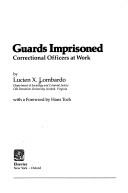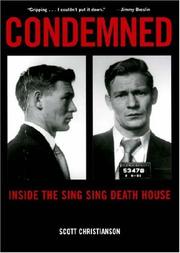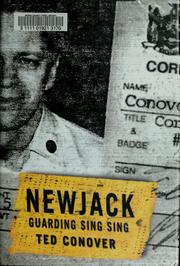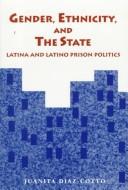| Listing 1 - 10 of 31 | << page >> |
Sort by
|
Book
Year: 1972 Publisher: New York : Bantam,
Abstract | Keywords | Export | Availability | Bookmark
 Loading...
Loading...Choose an application
- Reference Manager
- EndNote
- RefWorks (Direct export to RefWorks)

ISBN: 0444990801 Year: 1982 Publisher: New York (N.Y.): Elsevier
Abstract | Keywords | Export | Availability | Bookmark
 Loading...
Loading...Choose an application
- Reference Manager
- EndNote
- RefWorks (Direct export to RefWorks)

ISBN: 0814715966 Year: 2000 Publisher: New York London New York University Press
Abstract | Keywords | Export | Availability | Bookmark
 Loading...
Loading...Choose an application
- Reference Manager
- EndNote
- RefWorks (Direct export to RefWorks)

ISBN: 0375501770 Year: 2000 Publisher: New York Random House
Abstract | Keywords | Export | Availability | Bookmark
 Loading...
Loading...Choose an application
- Reference Manager
- EndNote
- RefWorks (Direct export to RefWorks)
Sing Sing Prison --- Ossining Correctional Facility --- Conover, Ted
Book
ISBN: 9781608337507 1608337502 9781626982840 Year: 2018 Publisher: Maryknoll, New York
Abstract | Keywords | Export | Availability | Bookmark
 Loading...
Loading...Choose an application
- Reference Manager
- EndNote
- RefWorks (Direct export to RefWorks)
Church work with prisoners. --- Prisoners --- Religious life. --- Lemmert, Ronald D. --- Sing Sing Correctional Facility. --- Prisons --- Religious work with prisoners --- Religious life --- Christianity --- New York (State). --- Ossining Correctional Facility

ISBN: 0791428168 079142815X Year: 1996 Volume: *3 Publisher: Albany State University of New York Press
Abstract | Keywords | Export | Availability | Bookmark
 Loading...
Loading...Choose an application
- Reference Manager
- EndNote
- RefWorks (Direct export to RefWorks)
Corrections --- Discrimination in criminal justice administration --- Hispanic American prisoners --- Women prisoners --- Services correctionnels --- Discrimination dans l'administration de la justice pénale --- Prisonniers américains d'origine Latino-américaine --- Prisonnières --- Bedford Hills Correctional Facility (N.Y.) --- Green Haven Correctional Facility --- Discrimination dans l'administration de la justice pénale --- Prisonniers américains d'origine Latino-américaine --- Prisonnières --- New York (State) --- Hispanic american prisoners
Book
ISBN: 0813586569 0813586577 9780813586571 9780813586564 9780813586564 9780813586557 0813586550 9780813586540 0813586542 Year: 2017 Publisher: New Brunswick, NJ
Abstract | Keywords | Export | Availability | Bookmark
 Loading...
Loading...Choose an application
- Reference Manager
- EndNote
- RefWorks (Direct export to RefWorks)
Complicated Lives focuses on the lives of sixty-five drug-using girls in the juvenile justice system (living in group homes, a residential treatment center, and a youth correctional facility) who grew up in families characterized by parental drug use, violence, and child maltreatment. Vera Lopez situates girls' relationships with parents who fail to live up to idealized parenting norms and examines how these relationships change over time, and ultimately contribute to the girls' future drug use and involvement in the justice system. While Lopez's subjects express concerns and doubt in their chances for success, Lopez provides an optimistic prescription for reform and improvement of the lives of these young women and presents a number of suggestions ranging from enhanced cultural competency training for all juvenile justice professionals to developing stronger collaborations between youth and adult serving systems and agencies.
Female juvenile delinquents --- Teenage girls --- Children of drug abusers --- Drug abusers' children --- Drug abusers --- Adolescent girls --- Female adolescents --- Girls --- Teenagers --- Delinquent girls --- Juvenile delinquents --- Social conditions --- Drug use --- Family relationships --- drugs, girls, drug use, drug abuse, family, correctional facility, youth correctional facility, juvie, juvenile delinquent, drug addict, drug addiction, violence, child abuse, heroin, meth, crack, cocaine, amphetamines, methamphetamines, juvenile justice, group home.
Book
ISBN: 142141323X 1421413221 9781421413235 9781421413228 1421428504 9781421428505 Year: 2014 Publisher: Baltimore
Abstract | Keywords | Export | Availability | Bookmark
 Loading...
Loading...Choose an application
- Reference Manager
- EndNote
- RefWorks (Direct export to RefWorks)
How progressive good intentions failed at Coxsackie, once a model New York State prison for youth offenders.Should prisons attempt reform and uplift inmates or, by means of principled punishment, deter them from further wrongdoing? This debate has raged in Western Europe and in the United States at least since the late eighteenth century. Joseph F. Spillane examines the failure of progressive reform in New York State by focusing on Coxsackie, a New Deal reformatory built for young male offenders. Opened in 1935 to serve “adolescents adrift,” Coxsackie instead became an unstable and brutalizing prison. From the start, the liberal impulse underpinning the prison’s mission was overwhelmed by challenges it was unequipped or unwilling to face—drugs, gangs, and racial conflict.Spillane draws on detailed prison records to reconstruct a life behind bars in which “ungovernable” young men posed constant challenges to racial and cultural order. The New Deal order of the prison was unstable from the start; the politics of punishment quickly became the politics of race and social exclusion, and efforts to save liberal reform in postwar New York only deepened its failures. In 1977, inmates took hostages to focus attention on their grievances. The result was stricter discipline and an end to any pretense that Coxsackie was a reform institution.Why did the prison fail? For answers, Spillane immerses readers in the changing culture and racial makeup of the U.S. prison system and borrows from studies of colonial prisons, which emblematized efforts by an exploitative regime to impose cultural and racial restraint on others.In today’s era of mass incarceration, prisons have become conflict-ridden warehouses and powerful symbols of racism and inequality. This account challenges the conventional wisdom that America’s prison crisis is of comparatively recent vintage, showing instead how a racial and punitive system of control emerged from the ashes of a progressive ideal.
Prisons --- Prisoners --- Coxsackie Correctional Facility. --- Convicts --- Correctional institutions --- Imprisoned persons --- Incarcerated persons --- Prison inmates --- Dungeons --- Gaols --- Penitentiaries --- Inmates --- Inmates of institutions --- Imprisonment --- Prison-industrial complex --- Persons --- History of the Americas
Book
ISBN: 022641048X 9780226410487 9780226410203 022641020X 9780226410340 022641034X Year: 2017 Publisher: Chicago University of Chicago Press
Abstract | Keywords | Export | Availability | Bookmark
 Loading...
Loading...Choose an application
- Reference Manager
- EndNote
- RefWorks (Direct export to RefWorks)
For the past fifty years, America has been extraordinarily busy building prisons. Since 1970 we have tripled the total number of facilities, adding more than 1,200 new prisons to the landscape. This building boom has taken place across the country but is largely concentrated in rural southern towns. In 2007, John M. Eason moved his family to Forrest City, Arkansas, in search of answers to key questions about this trend: Why is America building so many prisons? Why now? And why in rural areas? Eason quickly learned that rural demand for prisons is complicated. Towns like Forrest City choose to build prisons not simply in hopes of landing jobs or economic wellbeing, but also to protect and improve their reputations. For some rural leaders, fostering a prison in their town is a means of achieving order in a rapidly changing world. Taking us into the decision-making meetings and tracking the impact of prisons on economic development, poverty, and race, Eason demonstrates how groups of elite whites and black leaders share power. Situating prisons within dynamic shifts that rural economies are undergoing and showing how racially diverse communities lobby for prison construction, Big House on the Prairie is a remarkable glimpse into the ways a prison economy takes shape and operates.
Prisons --- Sociology, Rural. --- Social aspects --- Location --- Forrest City Federal Correctional Facility. --- Forrest City (Ark.) --- United States --- Social conditions. --- Rural conditions --- ghetto. --- political economy. --- prison industrial complex. --- prisons. --- punishment. --- racism. --- rural.
Book
ISBN: 9780520961500 0520961501 9780520286153 0520286154 9780520286160 0520286162 Year: 2015 Publisher: Oakland, California
Abstract | Keywords | Export | Availability | Bookmark
 Loading...
Loading...Choose an application
- Reference Manager
- EndNote
- RefWorks (Direct export to RefWorks)
The resurrection of former prisons as museums has caught the attention of tourists along with scholars interested in studying what is known as dark tourism. Unsurprisingly, due to their grim subject matter, prison museums tend to invert the "Disneyland" experience, becoming the antithesis of "the happiest place on earth." In Escape to Prison, the culmination of years of international research, noted criminologist Michael Welch explores ten prison museums on six continents, examining the complex interplay between culture and punishment. From Alcatraz to the Argentine Penitentiary, museums constructed on the former locations of surveillance, torture, colonial control, and even rehabilitation tell unique tales about the economic, political, religious, and scientific roots of each site's historical relationship to punishment.
Prisons --- Dark tourism. --- Correctional institutions --- Historical museums. --- History --- History museums --- Museums --- Corrections institutions --- Penal institutions --- Corrections --- Public institutions --- Black tourism (Dark tourism) --- Grief tourism --- Thanatourism --- Tourism --- Dungeons --- Gaols --- Penitentiaries --- Imprisonment --- Prison-industrial complex --- Museums. --- History. --- alcatraz. --- architecture parlante. --- clink prison museum. --- correctional facility museums. --- correctional facility tours. --- crime and punishment tourism. --- criminologist. --- criminology. --- cultural power. --- dark tourism. --- famous correctional facilities. --- famous prisons. --- former prison museums. --- former prisons. --- historical prisons. --- history of prison system. --- history of prison. --- penal spectatorship. --- penal tourism. --- penitentiary museum. --- penitentiary tourism. --- penology. --- prison museums. --- prison tourism. --- the clink.
| Listing 1 - 10 of 31 | << page >> |
Sort by
|

 Search
Search Feedback
Feedback About UniCat
About UniCat  Help
Help News
News